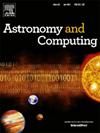Disentangling transients and their host galaxies with scarlet2: A framework to forward model multi-epoch imaging
IF 1.8
4区 物理与天体物理
Q2 ASTRONOMY & ASTROPHYSICS
引用次数: 0
Abstract
Many science cases for wide-field time-domain surveys rely on accurate identification and characterization of the galaxies hosting transient and variable objects. In the era of the Legacy Survey of Space and Time (LSST) at the Vera C. Rubin Observatory the number of known transient and variable sources will grow by orders of magnitude, and many of these sources will be blended with their host galaxies and neighboring galaxies. A diverse range of applications – including the classification of nuclear and non-nuclear sources, identification of potential host galaxies in deep fields, extraction of host galaxy spectral energy distributions without requiring a transient-free reference image, and combined analysis of photometry from multiple surveys – will benefit from a flexible framework to model time-domain imaging of transients. We describe a time-domain extension of the scarlet2 scene modeling code for multi-epoch, multi-band, and multi-resolution imaging data to extract simultaneous transient and host galaxy models. scarlet2 leverages the benefits of data-driven priors on galaxy morphology, is fully GPU compatible, and can jointly model multi-resolution data from ground and space-based surveys. We demonstrate the method on simulated LSST-like supernova imaging, low-resolution Zwicky Transient Facility imaging of tidal disruption events, and Hyper Suprime Cam imaging of variable AGN out to in the COSMOS fields. We show that scarlet2 models provide accurate transient and host galaxy models as well as accurate measurement of host–transient spatial offsets, and demonstrate future applications to the search for ‘wandering’ massive black holes.
用scarlet2分离瞬态及其宿主星系:一种多历元成像正演模型框架
许多宽视场时域巡天的科学案例依赖于对承载瞬态和可变天体的星系的准确识别和表征。在Vera C. Rubin天文台的遗留时空调查(LSST)时代,已知的瞬态和可变源的数量将以数量级增长,其中许多源将与它们的宿主星系和邻近星系混合。各种各样的应用——包括核源和非核源的分类,在深场中潜在宿主星系的识别,在不需要无瞬态参考图像的情况下提取宿主星系的光谱能量分布,以及从多个调查中综合分析光度——将受益于一个灵活的框架来模拟瞬态的时域成像。我们描述了scarlet2场景建模代码的时域扩展,用于多历元、多波段和多分辨率成像数据,以提取同时存在的瞬态和宿主星系模型。scarlet2利用了数据驱动的星系形态先验的优势,完全兼容GPU,可以联合模拟来自地面和太空调查的多分辨率数据。我们在模拟lsst类超新星成像、潮汐破坏事件的低分辨率Zwicky瞬态设备成像和COSMOS场中z=4的可变AGN的Hyper prime Cam成像中演示了该方法。我们证明了scarlet2模型提供了精确的瞬态和宿主星系模型,以及对宿主瞬态空间偏移的精确测量,并展示了未来在寻找“流浪”大质量黑洞方面的应用。
本文章由计算机程序翻译,如有差异,请以英文原文为准。
求助全文
约1分钟内获得全文
求助全文
来源期刊

Astronomy and Computing
ASTRONOMY & ASTROPHYSICSCOMPUTER SCIENCE,-COMPUTER SCIENCE, INTERDISCIPLINARY APPLICATIONS
CiteScore
4.10
自引率
8.00%
发文量
67
期刊介绍:
Astronomy and Computing is a peer-reviewed journal that focuses on the broad area between astronomy, computer science and information technology. The journal aims to publish the work of scientists and (software) engineers in all aspects of astronomical computing, including the collection, analysis, reduction, visualisation, preservation and dissemination of data, and the development of astronomical software and simulations. The journal covers applications for academic computer science techniques to astronomy, as well as novel applications of information technologies within astronomy.
 求助内容:
求助内容: 应助结果提醒方式:
应助结果提醒方式:


